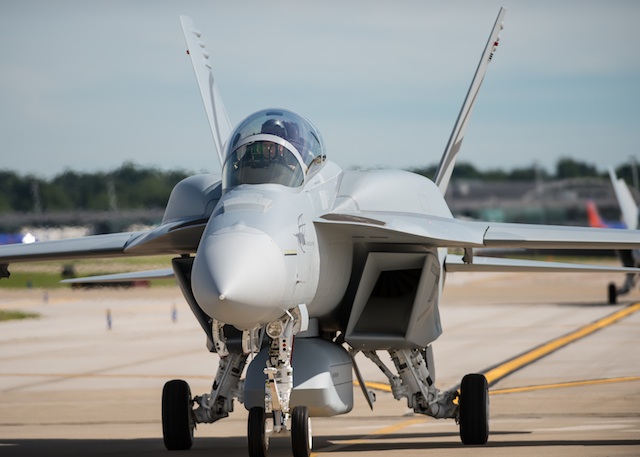It's crunch time for Boeing's F/A-18 production line, with the company needing to secure orders in fiscal year 2015 to avoid a possible production shut down at the end of 2016.
Despite being short on time, Boeing remains outwardly confident, citing interest by foreign customers and a need by the US military for 50 to 100 additional electronic attack aircraft.
Boeing insists the F/A-18, particularly the new Advanced Super Hornet, is proven, affordable and able to counter threats for decades to come, making it an attractive alternative to Lockheed Martin’s F-35 Joint Strike Fighter.
Boeing’s vice president of the F/A-18 programme Mike Gibbons tells Flightglobal he sees “multiple opportunities” for orders by the US government in its fiscal year 2015 budget, the first draft of which is due out in early March.
"We can see a future that keeps us in production beyond 2020," he says. "There is a lot of opportunity domestically with the US Navy, but also internationally with a lot of different customers."

Boeing says new "conformal fuel tanks" added to the upper external fuselage of its F/A-18 Advanced Super Hornet increases the aircraft's range by 130nm (241km). Boeing.
Not everyone is so confident.
“I’m not terribly optimistic,” says analyst Richard Aboulafia, vice president of consulting firm Teal Group.
Aboulafia said last week at the Pacific Northwest Aerospace Alliance conference in Washington state that Boeing must decide by March whether to order the long-lead time materials it will need to keep the production line going post 2016.
Also, a desire by the Defense Department for more aircraft “might not matter” as defence spending dries up, says Aboulafia, adding that Boeing might consider keeping the F/A-18 line running with company money until more orders materialise.
Gibbons says its too early to consider self-funding the line with so-called “white tails”, which are unsold aircraft built on spec.
"Certainly we would not have to make that decision through the course of this year,“ he says.
But Boeing notes the US government’s recently-passed fiscal year 2014 budget includes $75 million for “advanced procurement” of F/A-18 long-lead materials like forgings for bulkheads and landing gears.
That’s no guarantee of an order, but it “helps take the immediate heat off,” Boeing says.
In addition, the company says it will “continue to fund long-lead items if it makes good business sense.”
CLOCK IS TICKING
By spring of 2015, Boeing expects to build the last of 161 aircraft ordered by the US government as part of a multi-year contract. That order included 103 F/A-18E/F Super Hornets and 58 E/A-18G Growlers, the electronic attack version of the fighter.
Then Boeing begins building the final 47 aircraft on order: 11 Super Hornets from a supplemental US government buy in 2013, 24 Growlers funded in the fiscal year 2014 budget and 12 Growlers ordered by the Royal Australian Air Force.
Without further orders, the line will likely shut in late 2016 when the last aircraft are completed, Boeing says.
“A near-term decision to include Super Hornets or Growlers in the FY 2015 budget is critical,” Boeing says.
BUDGET BATTLE
Boeing is waiting to see if funds for more aircraft are included in President Barack Obama’s budget proposal, expected in early March.
If not, Boeing says it will lobby Congress.
"This will play out through the whole year,” Gibbons says.
And he insists Boeing has a strong case.
The Defense Department needs more Growlers to protect all its aircraft, and the F/A-18 can provide “risk mitigation” during development of Lockheed Martin’s delayed F-35 Joint Strike Fighter, Gibbons says.
Also, Super Hornets cost $52 million with engines, avionics and weapons systems, while Growlers cost about $8 to $9 million more – far less than the F-35, according to Gibbons.
Aboulafia has estimated F-35s cost roughly $135 million, while Lockheed said last year the cost was “under $100 million” and will reach $85 million by 2019.
Operating costs are also less — about $16,000 to $17,000 per flight hour, says Gibbons.
By comparison, in May 2013 the US Air Force estimated its F-35As would cost $32,000 hourly.
ADVANCED SUPER HORNET
Gibbons says improvements will ensure the F/A-18 "outpaces threats" beyond 2030.
The Advanced Super Hornet, which is still being developed and tested, has better engines, avionics and weapons systems, including an upgraded radar and improved infrared search-and-track abilities, Boeing says.
It has a belly-mounted "enclosed weapons pod" that can carry 2,500lb (1,134kg) of munitions and external "conformal fuel tanks that can hold 3,500lb of fuel.

The "enclosed weapons pod" on the belly of Boeing's F/A-18 Advanced Super Hornet minimises the aircraft's radar cross section, says Boeing. Boeing.
Those and other changes give the Advanced a combat radius of more than 700nm (1,296km), 130nm more than the Super Hornet, and half the radar signature, Boeing says.
Though the company does not say how the radar signature compares to the F-35’s, it insists the Advanced will be “highly effective” against the same air-to-air and air-to-surface threats faced by F-35s during the opening phases of future conflicts.
In addition, Boeing argues stealth is "perishable" due to improvements in aircraft detection.
That's why electronic attack protection from the Growler "is essential to future...combat operations," Boeing says.
Boeing first flew an F/A-18 with some of the improvements in August 2013 and has additional tests scheduled this year.
New aircraft can be purchased as Advanced models, or existing Block II F/A-18s can be upgraded, according to Boeing.
LOOKING OVERSEAS
Boeing thinks more foreign orders are also possible, potentially from Denmark, which is evaluating F/A-18s to replace its fleet of Lockheed Martin F-16s.
The company also hopes to finagle orders out of Canada, which had planned to acquire 65 F-35s but is reportedly now considering other options.
Boeing says it expects to learn of Canada’s decision early this year.
Other prospects include
Malaysia, Kuwait and other Middle East countries, says Boeing.
Source: FlightGlobal.com























